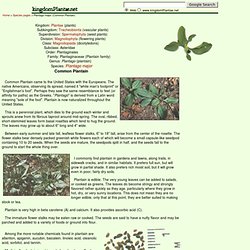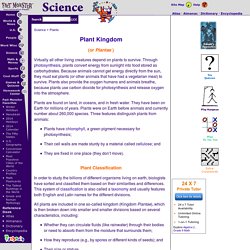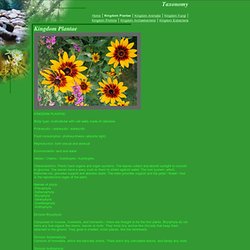

Home — The Plant List. Google Image Result for. Google Image Result for. Biology: Nonvascular Plants Defined. The Plant Kingdom. Natural Perspective: Plant Kingdom. Page 17 of 38 The Plant Kingdom (Plantae) (Last modified: 20 June 2007) Plants provide nourishment for our bodies and souls.

With the help of protists and fungi, plants provide the oxygen we breathe and the food that sustains us -- either directly or indirectly, by feeding other animals. Plants provide shade over our heads and cool carpets under our feet while surrounding us with beautiful colors and marking the change of seasons. Prominent plants give us a handle on ecological communities. Classification of the plant kingdom can be especially confusing to the amateur naturalist. A palm tree has more in common with a blade of grass than with other trees. All of these higher-level groupings are decidedly lopsided: the vast majority of the 270,000 plant species are flowering herbs.
Mosses and Allies (Bryophyta and allies) Mosses are non-vascular plants -- they cannot transport fluids through their bodies. Though small in stature, mosses are very important members of our ecosystem. Plantago major (Common Plantain) Among the more notable chemicals found in plantain are allantion, apigenin, aucubin, baicalein, linoleic acid, oleanolic acid, sorbitol, and tannin.

Medicinally, plantain is astringent, demulcent, emollient, cooling, vulnerary, expectorant, antimicrobial, antiviral, antitoxin, and diuretic. It effects blood sugar, usually lowering it. It has been used to treat lung disorders and stomach problems. For these purposes, a tea is made from either the leaves or the whole plant and taken internally. This same tea may be used as a mouthwash to treat sores in the mouth and toothaches. I've begun making a plantain ointment which is proving to be remarkably effective. I should add that plantain is currently being marketed as a stop smoking aid.
Plant Kingdom. Virtually all other living creatures depend on plants to survive.

Through photosynthesis, plants convert energy from sunlight into food stored as carbohydrates. Because animals cannot get energy directly from the sun, they must eat plants (or other animals that have had a vegetarian meal) to survive. Kingdom Plantae. Body type: multicellular with cell walls made of cellulose Prokaryotic / eukaryotic: eukaryotic Food consumption: photosynthesis (absorbs light) Reproduction: both sexual and asexual Environments: land and water Hetero / Chemo / Autotrophic: Autotrophic Characteristics: Plants have organs and organ systems.

Names of phyla: -Filicophyta -Sphenophyta -Bryophyta -Ginkophyta -Coniferophyta -Anthophyta Division Bryophyta: Composed of mosses, liverworts, and hornworts-- these are thought to be the first plants. Division Sphenophyta: Consists of horsetails, which are basically stems. Division Anthophyta: Division anthophyta is the largest grouping of flowering plants. Division Coniferophyta: These are plants that bear their seeds in the form of a cone.
Division Ginkgophyta: Plants that are domestic to China and when reproducing, the females egg produces a very bad smell. Division Filicophyta: Ferns are just about the only type of plant that is in division filicophyta. Introduction to the Plantae. The Plantae includes all land plants: mosses, ferns, conifers, flowering plants, and so on—an amazing range of diverse forms.

With more than 250,000 species, they are second in size only to the arthropoda. Plants have been around for a very long time. The plants first appeared in the Ordovician, but did not begin to resemble modern plants until the Late Silurian.